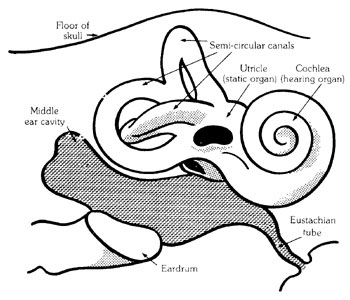Fortunately Type III spatial disorientation or vestibulo-ocular disorganization is a rare variation. In this type, the pilot is aware that he/she is disoriented and is unable to control the aircraft because reflex eye movements prevent instrument interpretation. My nickname for this is “Tits up” disorientation - chances of survival are remote with salvation being an ejection seat or a deep belief in the Lord! The sensations of this type can be mimicked by rolling down a grassy hill. The resulting intense vertigo (spinning) makes walking a straight line impossible. Controlling an aircraft would be out of the question! Viral infection of the inner ear organ (labyrinthitis) can also result in vertigo with associated nausea. This condition can complicate a viral upper respiratory infection (common cold), one of the reasons for grounding yourself until fully recovered.
Type III spatial disorientation can also be induced by the pilot in-flight. This condition is called the coriolis effect. It results from simultaneous stimulation of two or more of the semicircular canals in the inner ear (Illustration 24) This can occur in IMC when the pilot initiates a turn and simultaneously looks up or down with head movement. The stimuli to the brain are overpowering and produce a tumbling sensation. Rapid reflex movements of the eyes (nystagmus) makes instrument interpretation and aircraft control impossible. Prevention comes with a disciplined instrument scan - eye movement only. By holding the head still, only one set of semicircular canals is stimulated by the rolling movement of the aircraft - Vertigo and nystagmus are averted.
It is quite possible that more than one type of disorientation may come into play in an accident. A pilot suffering from unrecognized spatial disorientation (Type I) may receive an altitude alert from a vigilant air traffic controller. Distraction or fixation may result in progression to recognized (Type II) disorientation as instrument skill deteriorates. Over-controlling the aircraft and sudden head movement in search for the elusive runway environment may induce the coriolis effect (Type III). The odds of survival in this escalating scenario would be close to nil!
